MITS6004 Case Study: Detailed Report on Nike's ERP Implementation
VerifiedAdded on 2022/08/29
|10
|2145
|35
Report
AI Summary
This report provides a comprehensive analysis of Nike's Enterprise Resource Planning (ERP) implementation. It begins by examining the use of Organizational Project Management (OPM3) in identifying and addressing problems with the initial demand planning system. The report then explores the three primary factors that contributed to Nike's successful ERP implementation, including phased rollout and extensive employee training. Furthermore, it discusses the rationale behind Nike's decision to adopt a phased rollout approach, highlighting the benefits of this strategy in terms of risk management, resource evaluation, market entry, and customer feedback. The report draws on various sources to support its findings, offering a detailed case study of Nike's ERP journey and its implications for business process management and project success.
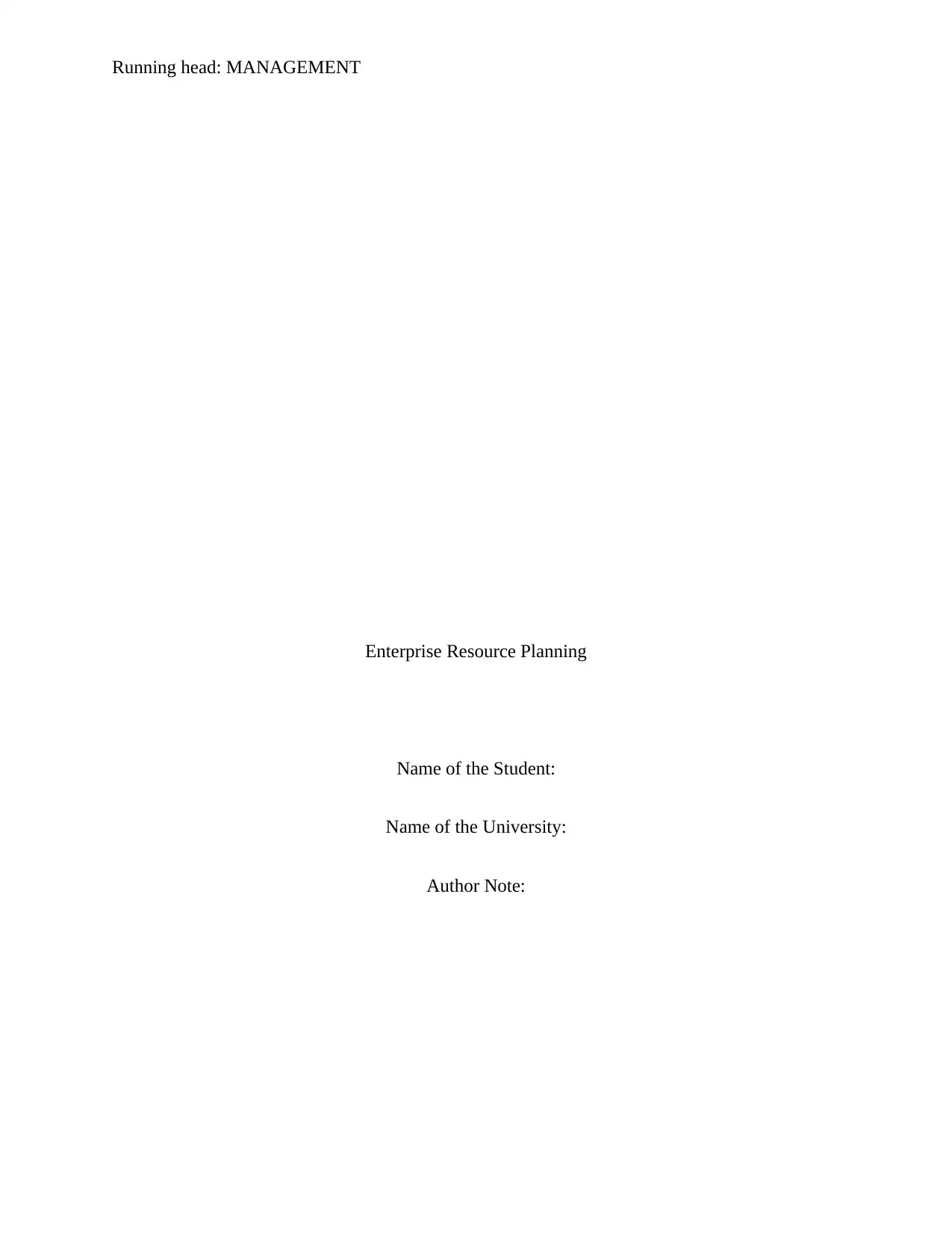
Running head: MANAGEMENT
Enterprise Resource Planning
Name of the Student:
Name of the University:
Author Note:
Enterprise Resource Planning
Name of the Student:
Name of the University:
Author Note:
Paraphrase This Document
Need a fresh take? Get an instant paraphrase of this document with our AI Paraphraser
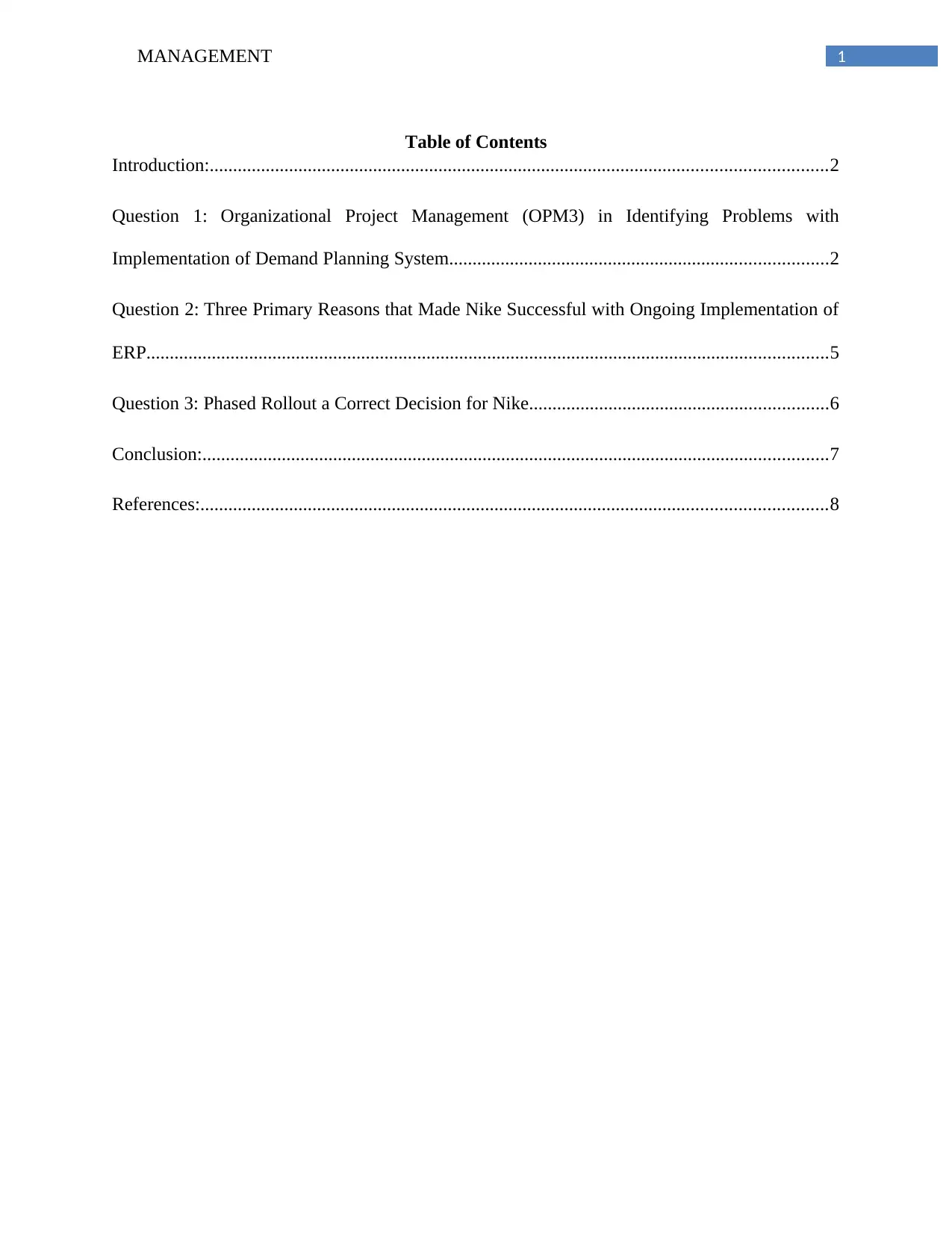
1MANAGEMENT
Table of Contents
Introduction:....................................................................................................................................2
Question 1: Organizational Project Management (OPM3) in Identifying Problems with
Implementation of Demand Planning System.................................................................................2
Question 2: Three Primary Reasons that Made Nike Successful with Ongoing Implementation of
ERP..................................................................................................................................................5
Question 3: Phased Rollout a Correct Decision for Nike................................................................6
Conclusion:......................................................................................................................................7
References:......................................................................................................................................8
Table of Contents
Introduction:....................................................................................................................................2
Question 1: Organizational Project Management (OPM3) in Identifying Problems with
Implementation of Demand Planning System.................................................................................2
Question 2: Three Primary Reasons that Made Nike Successful with Ongoing Implementation of
ERP..................................................................................................................................................5
Question 3: Phased Rollout a Correct Decision for Nike................................................................6
Conclusion:......................................................................................................................................7
References:......................................................................................................................................8

2MANAGEMENT
Introduction:
The report aims at providing an insight into the Enterprise Resource Planning (ERP)
implementation for Nike through answers derived from the various questions mentioned in the
following paragraphs.
Question 1: Organizational Project Management (OPM3) in Identifying Problems with
Implementation of Demand Planning System
Demand Planning refers to the procedure of demand forecasting for a service or product
such that it can be produced or delivered efficiently as per the customer satisfaction. Demand
planning is a vital step in planning of supply chain [1] The challenge with implementing the
demand planning system ranges from the internal and external issues to the organizational and
the logistical issues. The external issues are primarily related to insufficient industry data or the
market conditions while the internal issues relate to the absence of management support or the
forecasting tools that makes it difficult in generating the relevant forecast. These problems can
be identified with Organizational Project Management (OPM 3).
The models of OPM has been cited as a tool for measuring the organization’s consistent
implementation and adoption of the recommended practice in the project management. The
maturity models of OPM increasingly stress on the two basic fundamental concepts within its
construct [2]. This includes the recommended practice meant for the project, program or the
portfolio management which includes benefits management, risk management and scheduling
practices. This also involves a generic pathway for achieving the maturity of the process which
includes measurement of effectiveness, institutionalization, performance monitoring, tailoring,
optimization and the process analytics. Thus, the OPM model represents capability enhancing
Introduction:
The report aims at providing an insight into the Enterprise Resource Planning (ERP)
implementation for Nike through answers derived from the various questions mentioned in the
following paragraphs.
Question 1: Organizational Project Management (OPM3) in Identifying Problems with
Implementation of Demand Planning System
Demand Planning refers to the procedure of demand forecasting for a service or product
such that it can be produced or delivered efficiently as per the customer satisfaction. Demand
planning is a vital step in planning of supply chain [1] The challenge with implementing the
demand planning system ranges from the internal and external issues to the organizational and
the logistical issues. The external issues are primarily related to insufficient industry data or the
market conditions while the internal issues relate to the absence of management support or the
forecasting tools that makes it difficult in generating the relevant forecast. These problems can
be identified with Organizational Project Management (OPM 3).
The models of OPM has been cited as a tool for measuring the organization’s consistent
implementation and adoption of the recommended practice in the project management. The
maturity models of OPM increasingly stress on the two basic fundamental concepts within its
construct [2]. This includes the recommended practice meant for the project, program or the
portfolio management which includes benefits management, risk management and scheduling
practices. This also involves a generic pathway for achieving the maturity of the process which
includes measurement of effectiveness, institutionalization, performance monitoring, tailoring,
optimization and the process analytics. Thus, the OPM model represents capability enhancing
⊘ This is a preview!⊘
Do you want full access?
Subscribe today to unlock all pages.

Trusted by 1+ million students worldwide
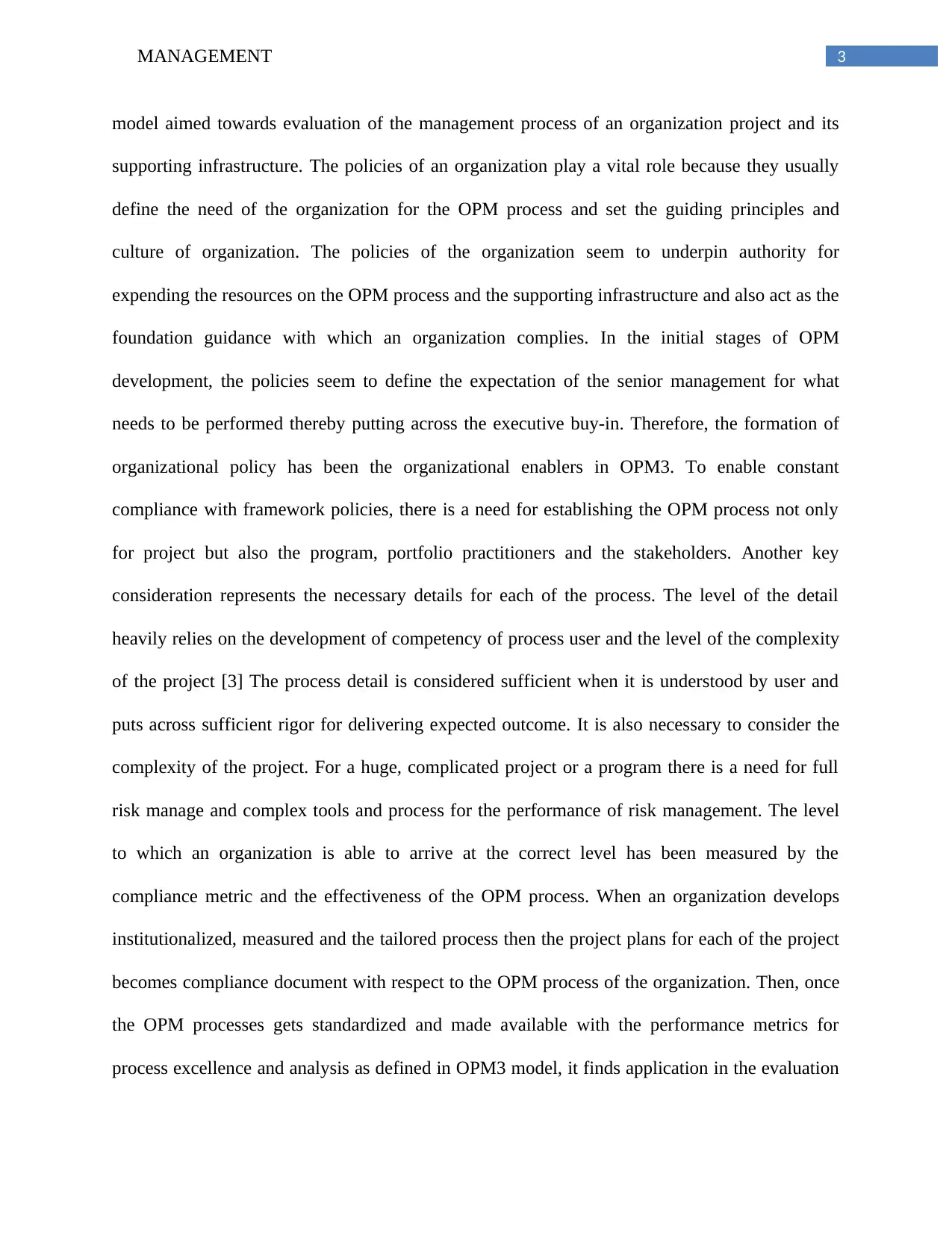
3MANAGEMENT
model aimed towards evaluation of the management process of an organization project and its
supporting infrastructure. The policies of an organization play a vital role because they usually
define the need of the organization for the OPM process and set the guiding principles and
culture of organization. The policies of the organization seem to underpin authority for
expending the resources on the OPM process and the supporting infrastructure and also act as the
foundation guidance with which an organization complies. In the initial stages of OPM
development, the policies seem to define the expectation of the senior management for what
needs to be performed thereby putting across the executive buy-in. Therefore, the formation of
organizational policy has been the organizational enablers in OPM3. To enable constant
compliance with framework policies, there is a need for establishing the OPM process not only
for project but also the program, portfolio practitioners and the stakeholders. Another key
consideration represents the necessary details for each of the process. The level of the detail
heavily relies on the development of competency of process user and the level of the complexity
of the project [3] The process detail is considered sufficient when it is understood by user and
puts across sufficient rigor for delivering expected outcome. It is also necessary to consider the
complexity of the project. For a huge, complicated project or a program there is a need for full
risk manage and complex tools and process for the performance of risk management. The level
to which an organization is able to arrive at the correct level has been measured by the
compliance metric and the effectiveness of the OPM process. When an organization develops
institutionalized, measured and the tailored process then the project plans for each of the project
becomes compliance document with respect to the OPM process of the organization. Then, once
the OPM processes gets standardized and made available with the performance metrics for
process excellence and analysis as defined in OPM3 model, it finds application in the evaluation
model aimed towards evaluation of the management process of an organization project and its
supporting infrastructure. The policies of an organization play a vital role because they usually
define the need of the organization for the OPM process and set the guiding principles and
culture of organization. The policies of the organization seem to underpin authority for
expending the resources on the OPM process and the supporting infrastructure and also act as the
foundation guidance with which an organization complies. In the initial stages of OPM
development, the policies seem to define the expectation of the senior management for what
needs to be performed thereby putting across the executive buy-in. Therefore, the formation of
organizational policy has been the organizational enablers in OPM3. To enable constant
compliance with framework policies, there is a need for establishing the OPM process not only
for project but also the program, portfolio practitioners and the stakeholders. Another key
consideration represents the necessary details for each of the process. The level of the detail
heavily relies on the development of competency of process user and the level of the complexity
of the project [3] The process detail is considered sufficient when it is understood by user and
puts across sufficient rigor for delivering expected outcome. It is also necessary to consider the
complexity of the project. For a huge, complicated project or a program there is a need for full
risk manage and complex tools and process for the performance of risk management. The level
to which an organization is able to arrive at the correct level has been measured by the
compliance metric and the effectiveness of the OPM process. When an organization develops
institutionalized, measured and the tailored process then the project plans for each of the project
becomes compliance document with respect to the OPM process of the organization. Then, once
the OPM processes gets standardized and made available with the performance metrics for
process excellence and analysis as defined in OPM3 model, it finds application in the evaluation
Paraphrase This Document
Need a fresh take? Get an instant paraphrase of this document with our AI Paraphraser
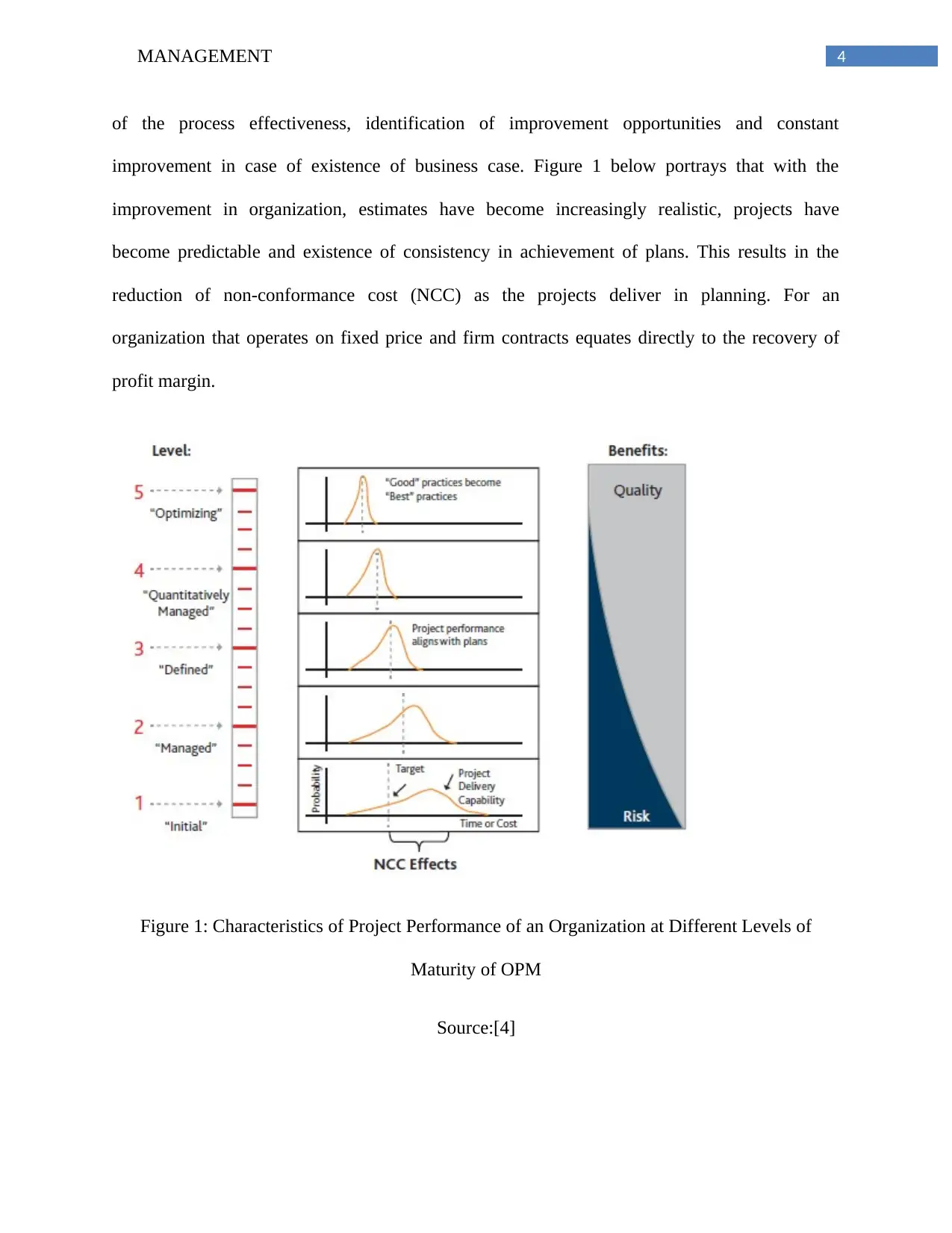
4MANAGEMENT
of the process effectiveness, identification of improvement opportunities and constant
improvement in case of existence of business case. Figure 1 below portrays that with the
improvement in organization, estimates have become increasingly realistic, projects have
become predictable and existence of consistency in achievement of plans. This results in the
reduction of non-conformance cost (NCC) as the projects deliver in planning. For an
organization that operates on fixed price and firm contracts equates directly to the recovery of
profit margin.
Figure 1: Characteristics of Project Performance of an Organization at Different Levels of
Maturity of OPM
Source:[4]
of the process effectiveness, identification of improvement opportunities and constant
improvement in case of existence of business case. Figure 1 below portrays that with the
improvement in organization, estimates have become increasingly realistic, projects have
become predictable and existence of consistency in achievement of plans. This results in the
reduction of non-conformance cost (NCC) as the projects deliver in planning. For an
organization that operates on fixed price and firm contracts equates directly to the recovery of
profit margin.
Figure 1: Characteristics of Project Performance of an Organization at Different Levels of
Maturity of OPM
Source:[4]
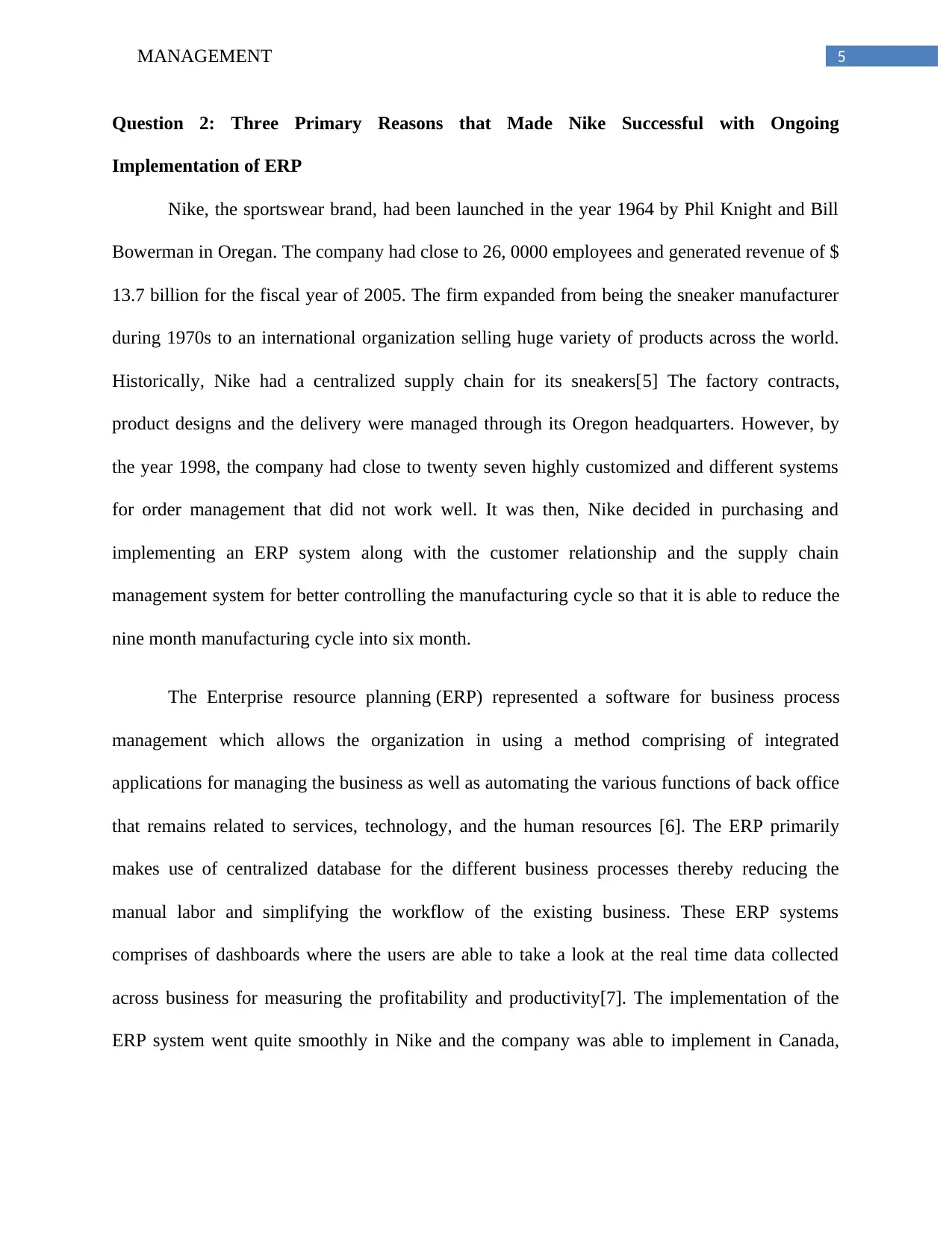
5MANAGEMENT
Question 2: Three Primary Reasons that Made Nike Successful with Ongoing
Implementation of ERP
Nike, the sportswear brand, had been launched in the year 1964 by Phil Knight and Bill
Bowerman in Oregan. The company had close to 26, 0000 employees and generated revenue of $
13.7 billion for the fiscal year of 2005. The firm expanded from being the sneaker manufacturer
during 1970s to an international organization selling huge variety of products across the world.
Historically, Nike had a centralized supply chain for its sneakers[5] The factory contracts,
product designs and the delivery were managed through its Oregon headquarters. However, by
the year 1998, the company had close to twenty seven highly customized and different systems
for order management that did not work well. It was then, Nike decided in purchasing and
implementing an ERP system along with the customer relationship and the supply chain
management system for better controlling the manufacturing cycle so that it is able to reduce the
nine month manufacturing cycle into six month.
The Enterprise resource planning (ERP) represented a software for business process
management which allows the organization in using a method comprising of integrated
applications for managing the business as well as automating the various functions of back office
that remains related to services, technology, and the human resources [6]. The ERP primarily
makes use of centralized database for the different business processes thereby reducing the
manual labor and simplifying the workflow of the existing business. These ERP systems
comprises of dashboards where the users are able to take a look at the real time data collected
across business for measuring the profitability and productivity[7]. The implementation of the
ERP system went quite smoothly in Nike and the company was able to implement in Canada,
Question 2: Three Primary Reasons that Made Nike Successful with Ongoing
Implementation of ERP
Nike, the sportswear brand, had been launched in the year 1964 by Phil Knight and Bill
Bowerman in Oregan. The company had close to 26, 0000 employees and generated revenue of $
13.7 billion for the fiscal year of 2005. The firm expanded from being the sneaker manufacturer
during 1970s to an international organization selling huge variety of products across the world.
Historically, Nike had a centralized supply chain for its sneakers[5] The factory contracts,
product designs and the delivery were managed through its Oregon headquarters. However, by
the year 1998, the company had close to twenty seven highly customized and different systems
for order management that did not work well. It was then, Nike decided in purchasing and
implementing an ERP system along with the customer relationship and the supply chain
management system for better controlling the manufacturing cycle so that it is able to reduce the
nine month manufacturing cycle into six month.
The Enterprise resource planning (ERP) represented a software for business process
management which allows the organization in using a method comprising of integrated
applications for managing the business as well as automating the various functions of back office
that remains related to services, technology, and the human resources [6]. The ERP primarily
makes use of centralized database for the different business processes thereby reducing the
manual labor and simplifying the workflow of the existing business. These ERP systems
comprises of dashboards where the users are able to take a look at the real time data collected
across business for measuring the profitability and productivity[7]. The implementation of the
ERP system went quite smoothly in Nike and the company was able to implement in Canada,
⊘ This is a preview!⊘
Do you want full access?
Subscribe today to unlock all pages.

Trusted by 1+ million students worldwide

6MANAGEMENT
Latin America, Asia Pacific, United States, Middle East, Africa and Europe. The key reasons for
the successful implementation of ERP in Nike are as follows [8]:
The implementation of ERP system followed phased roll out over the years
The Customer service representatives at the Nike received training for close to 140 to 180
hours.
The users remained locked from using the system unless they completed the entire course
of training.
Question 3: Phased Rollout a Correct Decision for Nike
Phased rollout represents either a method of software or a hardware migration which
takes into account the incremental execution of new system [9]. The phased rollout has been an
appropriate decision for Nike as it allowed the company to gradually adjust the newly
implemented ERP system. In fact, phased implementation acted as a method for the system
changeover from the existing to new one ERP system following a gradual process. The phased
approach thus enables the asset to make incremental additions to asset value, ensure learning by
doing, gaining credibility within the organization and justifying the incremental expenditures on
the things like well instrumentation, well control, training and role transition [10].
It has however been found that, technological challenges or risk of a project is higher
during its initial phase. Therefore, addressing it in phased out manner leads to a higher rate of
success. This allows the project team to engage with the relevant internal or external experts for
overcoming the challenges. When the challenges does not seem feasible it can be updated with
stakeholders and also look for necessary alternatives. This will also make the stakeholders in
realizing their presence.
Latin America, Asia Pacific, United States, Middle East, Africa and Europe. The key reasons for
the successful implementation of ERP in Nike are as follows [8]:
The implementation of ERP system followed phased roll out over the years
The Customer service representatives at the Nike received training for close to 140 to 180
hours.
The users remained locked from using the system unless they completed the entire course
of training.
Question 3: Phased Rollout a Correct Decision for Nike
Phased rollout represents either a method of software or a hardware migration which
takes into account the incremental execution of new system [9]. The phased rollout has been an
appropriate decision for Nike as it allowed the company to gradually adjust the newly
implemented ERP system. In fact, phased implementation acted as a method for the system
changeover from the existing to new one ERP system following a gradual process. The phased
approach thus enables the asset to make incremental additions to asset value, ensure learning by
doing, gaining credibility within the organization and justifying the incremental expenditures on
the things like well instrumentation, well control, training and role transition [10].
It has however been found that, technological challenges or risk of a project is higher
during its initial phase. Therefore, addressing it in phased out manner leads to a higher rate of
success. This allows the project team to engage with the relevant internal or external experts for
overcoming the challenges. When the challenges does not seem feasible it can be updated with
stakeholders and also look for necessary alternatives. This will also make the stakeholders in
realizing their presence.
Paraphrase This Document
Need a fresh take? Get an instant paraphrase of this document with our AI Paraphraser
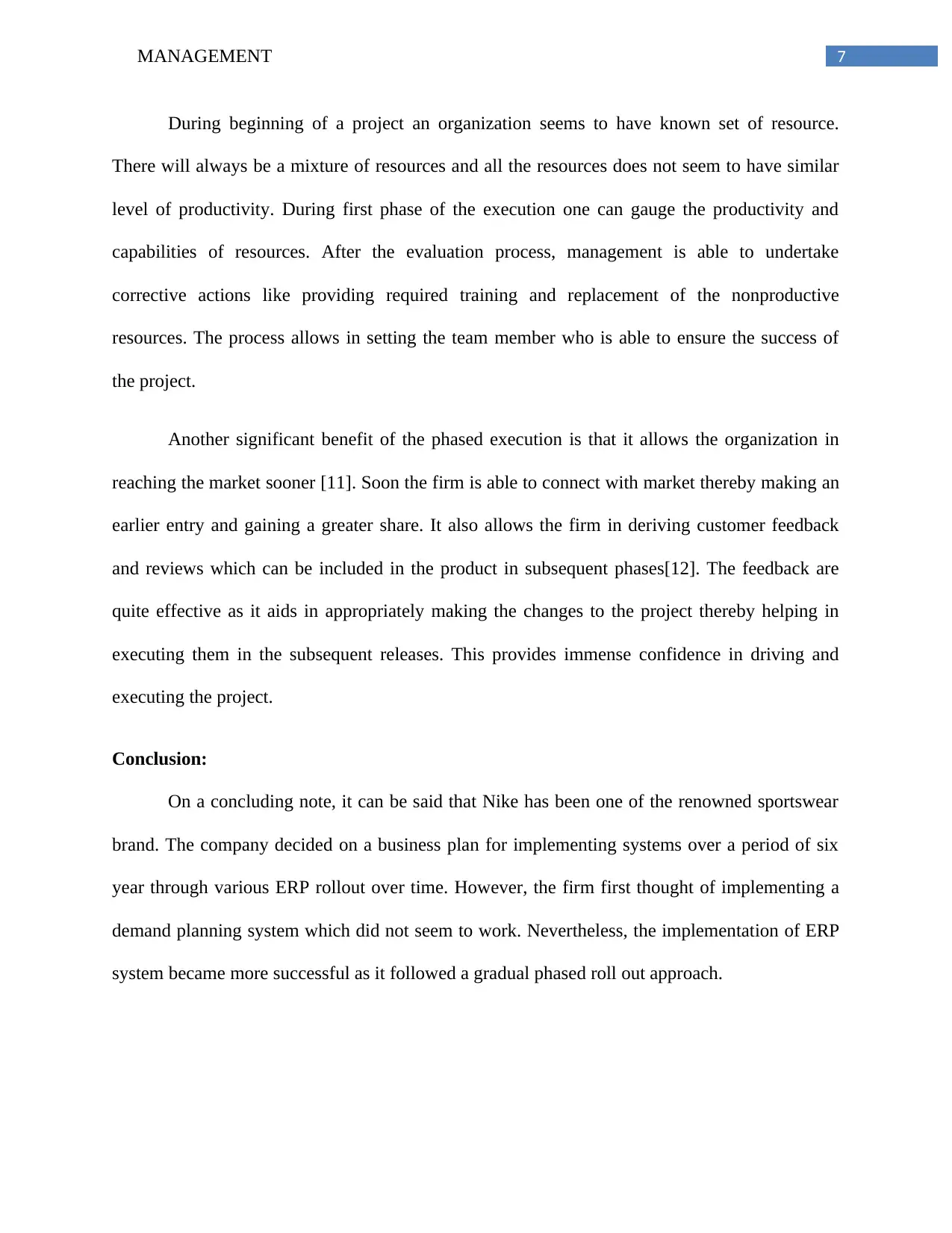
7MANAGEMENT
During beginning of a project an organization seems to have known set of resource.
There will always be a mixture of resources and all the resources does not seem to have similar
level of productivity. During first phase of the execution one can gauge the productivity and
capabilities of resources. After the evaluation process, management is able to undertake
corrective actions like providing required training and replacement of the nonproductive
resources. The process allows in setting the team member who is able to ensure the success of
the project.
Another significant benefit of the phased execution is that it allows the organization in
reaching the market sooner [11]. Soon the firm is able to connect with market thereby making an
earlier entry and gaining a greater share. It also allows the firm in deriving customer feedback
and reviews which can be included in the product in subsequent phases[12]. The feedback are
quite effective as it aids in appropriately making the changes to the project thereby helping in
executing them in the subsequent releases. This provides immense confidence in driving and
executing the project.
Conclusion:
On a concluding note, it can be said that Nike has been one of the renowned sportswear
brand. The company decided on a business plan for implementing systems over a period of six
year through various ERP rollout over time. However, the firm first thought of implementing a
demand planning system which did not seem to work. Nevertheless, the implementation of ERP
system became more successful as it followed a gradual phased roll out approach.
During beginning of a project an organization seems to have known set of resource.
There will always be a mixture of resources and all the resources does not seem to have similar
level of productivity. During first phase of the execution one can gauge the productivity and
capabilities of resources. After the evaluation process, management is able to undertake
corrective actions like providing required training and replacement of the nonproductive
resources. The process allows in setting the team member who is able to ensure the success of
the project.
Another significant benefit of the phased execution is that it allows the organization in
reaching the market sooner [11]. Soon the firm is able to connect with market thereby making an
earlier entry and gaining a greater share. It also allows the firm in deriving customer feedback
and reviews which can be included in the product in subsequent phases[12]. The feedback are
quite effective as it aids in appropriately making the changes to the project thereby helping in
executing them in the subsequent releases. This provides immense confidence in driving and
executing the project.
Conclusion:
On a concluding note, it can be said that Nike has been one of the renowned sportswear
brand. The company decided on a business plan for implementing systems over a period of six
year through various ERP rollout over time. However, the firm first thought of implementing a
demand planning system which did not seem to work. Nevertheless, the implementation of ERP
system became more successful as it followed a gradual phased roll out approach.
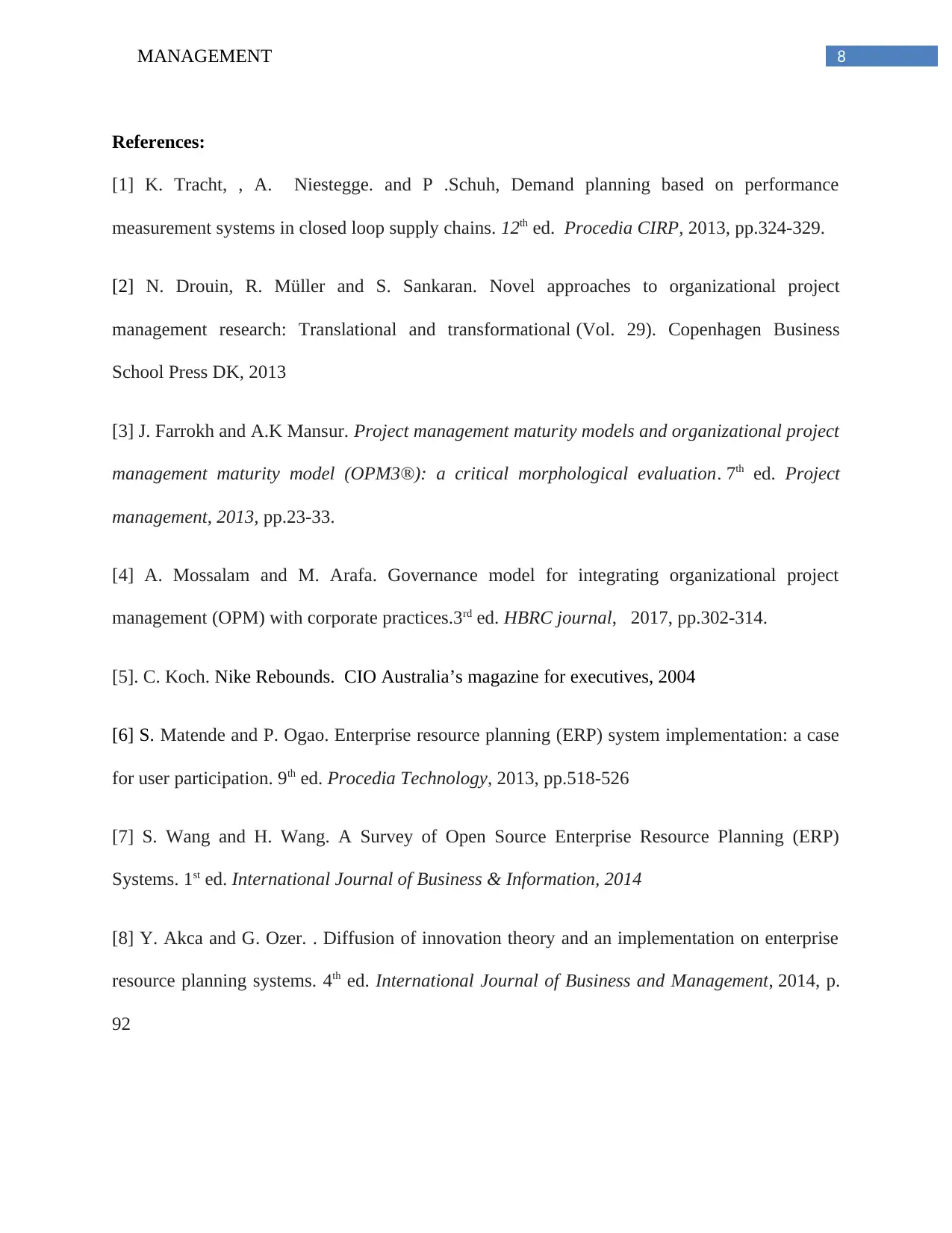
8MANAGEMENT
References:
[1] K. Tracht, , A. Niestegge. and P .Schuh, Demand planning based on performance
measurement systems in closed loop supply chains. 12th ed. Procedia CIRP, 2013, pp.324-329.
[2] N. Drouin, R. Müller and S. Sankaran. Novel approaches to organizational project
management research: Translational and transformational (Vol. 29). Copenhagen Business
School Press DK, 2013
[3] J. Farrokh and A.K Mansur. Project management maturity models and organizational project
management maturity model (OPM3®): a critical morphological evaluation. 7th ed. Project
management, 2013, pp.23-33.
[4] A. Mossalam and M. Arafa. Governance model for integrating organizational project
management (OPM) with corporate practices.3rd ed. HBRC journal, 2017, pp.302-314.
[5]. C. Koch. Nike Rebounds. CIO Australia’s magazine for executives, 2004
[6] S. Matende and P. Ogao. Enterprise resource planning (ERP) system implementation: a case
for user participation. 9th ed. Procedia Technology, 2013, pp.518-526
[7] S. Wang and H. Wang. A Survey of Open Source Enterprise Resource Planning (ERP)
Systems. 1st ed. International Journal of Business & Information, 2014
[8] Y. Akca and G. Ozer. . Diffusion of innovation theory and an implementation on enterprise
resource planning systems. 4th ed. International Journal of Business and Management, 2014, p.
92
References:
[1] K. Tracht, , A. Niestegge. and P .Schuh, Demand planning based on performance
measurement systems in closed loop supply chains. 12th ed. Procedia CIRP, 2013, pp.324-329.
[2] N. Drouin, R. Müller and S. Sankaran. Novel approaches to organizational project
management research: Translational and transformational (Vol. 29). Copenhagen Business
School Press DK, 2013
[3] J. Farrokh and A.K Mansur. Project management maturity models and organizational project
management maturity model (OPM3®): a critical morphological evaluation. 7th ed. Project
management, 2013, pp.23-33.
[4] A. Mossalam and M. Arafa. Governance model for integrating organizational project
management (OPM) with corporate practices.3rd ed. HBRC journal, 2017, pp.302-314.
[5]. C. Koch. Nike Rebounds. CIO Australia’s magazine for executives, 2004
[6] S. Matende and P. Ogao. Enterprise resource planning (ERP) system implementation: a case
for user participation. 9th ed. Procedia Technology, 2013, pp.518-526
[7] S. Wang and H. Wang. A Survey of Open Source Enterprise Resource Planning (ERP)
Systems. 1st ed. International Journal of Business & Information, 2014
[8] Y. Akca and G. Ozer. . Diffusion of innovation theory and an implementation on enterprise
resource planning systems. 4th ed. International Journal of Business and Management, 2014, p.
92
⊘ This is a preview!⊘
Do you want full access?
Subscribe today to unlock all pages.

Trusted by 1+ million students worldwide
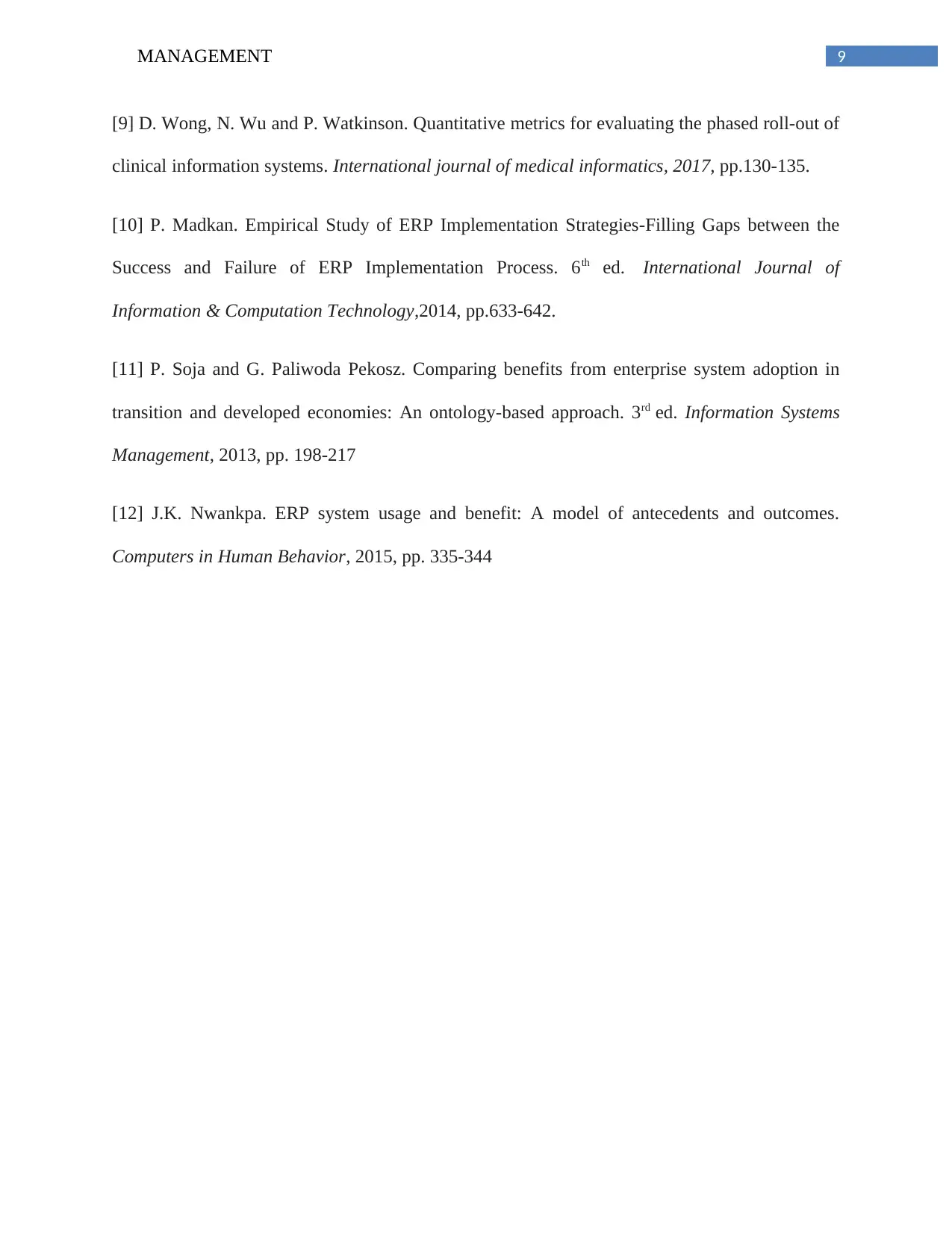
9MANAGEMENT
[9] D. Wong, N. Wu and P. Watkinson. Quantitative metrics for evaluating the phased roll-out of
clinical information systems. International journal of medical informatics, 2017, pp.130-135.
[10] P. Madkan. Empirical Study of ERP Implementation Strategies-Filling Gaps between the
Success and Failure of ERP Implementation Process. 6th ed. International Journal of
Information & Computation Technology,2014, pp.633-642.
[11] P. Soja and G. Paliwoda Pekosz. Comparing benefits from enterprise system adoption in
transition and developed economies: An ontology-based approach. 3rd ed. Information Systems
Management, 2013, pp. 198-217
[12] J.K. Nwankpa. ERP system usage and benefit: A model of antecedents and outcomes.
Computers in Human Behavior, 2015, pp. 335-344
[9] D. Wong, N. Wu and P. Watkinson. Quantitative metrics for evaluating the phased roll-out of
clinical information systems. International journal of medical informatics, 2017, pp.130-135.
[10] P. Madkan. Empirical Study of ERP Implementation Strategies-Filling Gaps between the
Success and Failure of ERP Implementation Process. 6th ed. International Journal of
Information & Computation Technology,2014, pp.633-642.
[11] P. Soja and G. Paliwoda Pekosz. Comparing benefits from enterprise system adoption in
transition and developed economies: An ontology-based approach. 3rd ed. Information Systems
Management, 2013, pp. 198-217
[12] J.K. Nwankpa. ERP system usage and benefit: A model of antecedents and outcomes.
Computers in Human Behavior, 2015, pp. 335-344
1 out of 10
Related Documents
Your All-in-One AI-Powered Toolkit for Academic Success.
+13062052269
info@desklib.com
Available 24*7 on WhatsApp / Email
![[object Object]](/_next/static/media/star-bottom.7253800d.svg)
Unlock your academic potential
Copyright © 2020–2025 A2Z Services. All Rights Reserved. Developed and managed by ZUCOL.





